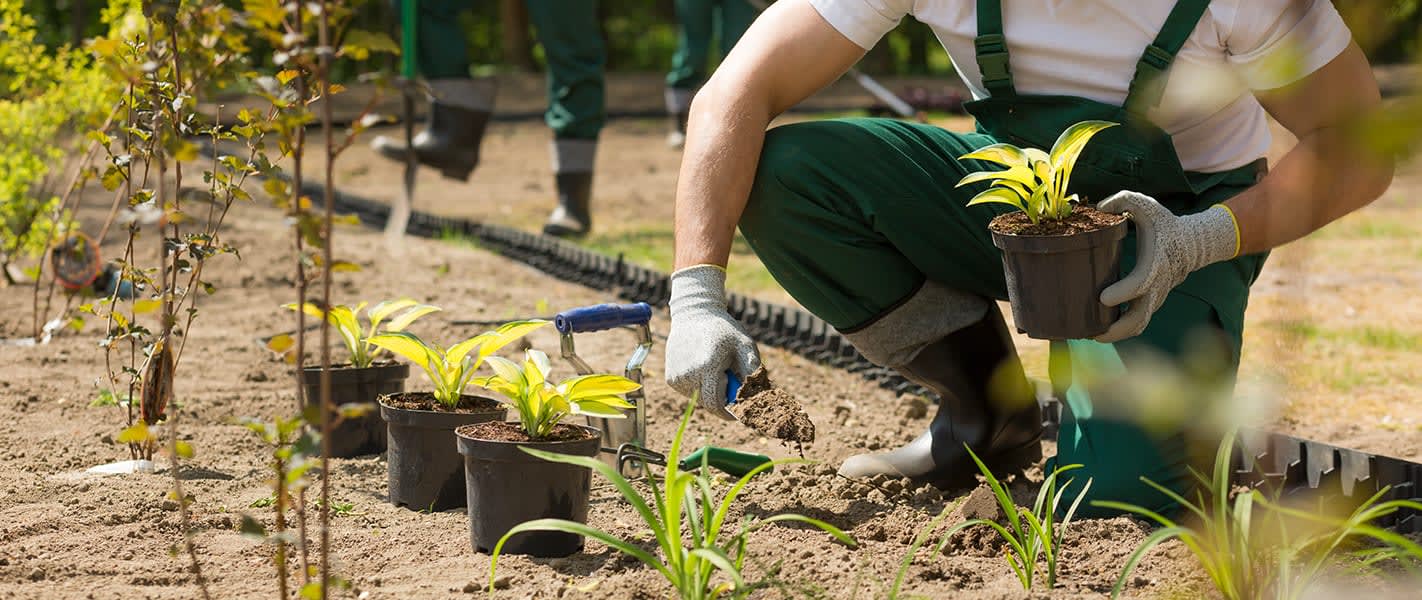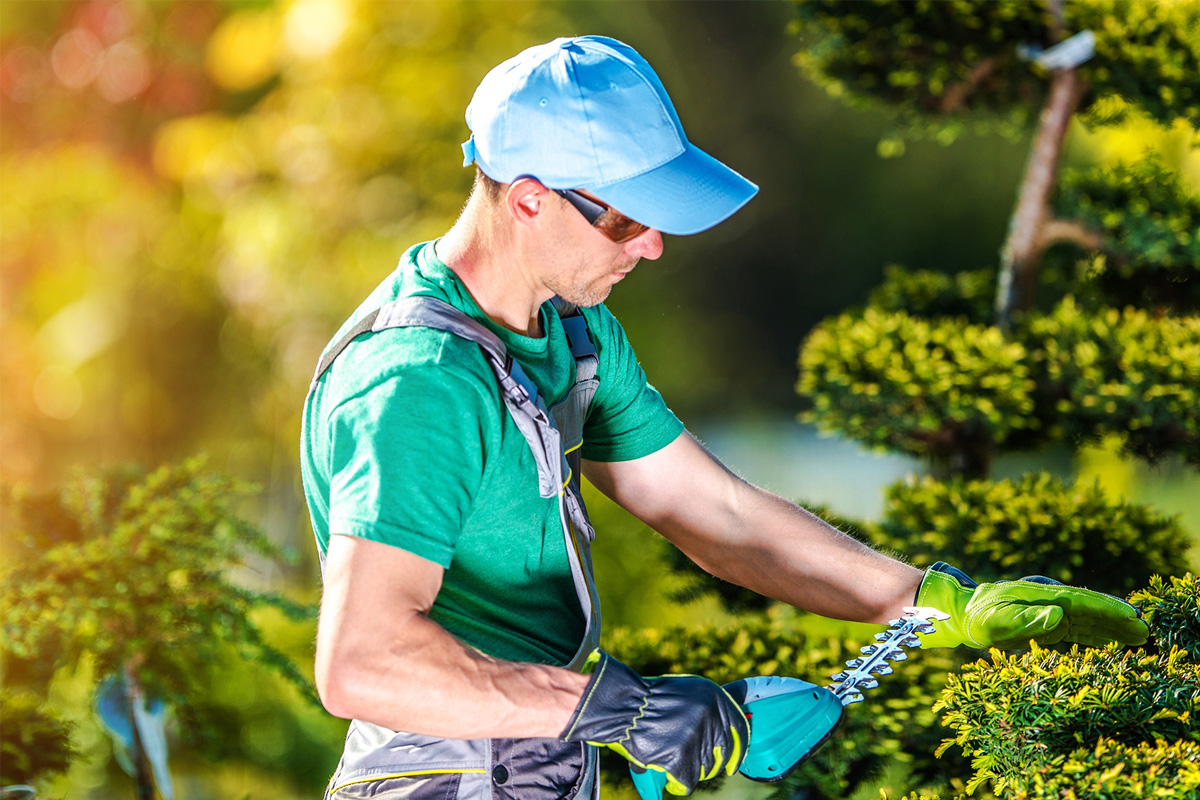Recognizing the Comprehensive Extent of Functions in Expert Landscaping Services
The comprehensive scope of expert landscaping services encompasses a selection of basic aspects - landscaping. It consists of landscape design principles, plant option, and hardscaping attributes. Furthermore, it deals with watering systems and upkeep approaches. Each facet plays a critical function in creating useful and visually pleasing outdoor spaces. Recognizing exactly how these components function with each other can expose much concerning the art and scientific research of landscape design. Nevertheless, the journey into this intricate area is just starting
Landscape Layout Principles
Effective landscape layout principles are vital for producing harmonious outside spaces that boost both visual charm and capability (Learn More). These principles guide the plan of components within the landscape, guaranteeing a cohesive aesthetic experience. Secret components include equilibrium, which disperses visual weight uniformly; proportion, which associates the size of numerous components per various other and the room; and unity, which develops a feeling of integrity through consistent themes and products

Plant Option and Installation
In the domain name of professional landscaping, plant choice and installment play a crucial function in accomplishing a thriving yard. Stressing native plant advantages, seasonal considerations, and the certain dirt and sunshine needs of each types assures a lasting and aesthetically pleasing landscape. Careful planning in these areas not only enhances biodiversity but likewise promotes long-lasting environmental health and wellness.
Indigenous Plant Benefits
Why should homeowners think about indigenous plants for their landscaping jobs? Native plants supply many benefits that improve both appearances and ecological sustainability. They are well-adapted to local climates, needing less water and maintenance contrasted to non-native types. This durability minimizes the requirement for chemical plant foods and pesticides, promoting a healthier community. Additionally, indigenous plants supply environment and food for regional wild animals, including pollinators, which can enhance biodiversity in property locations. Their familiarity with local dirt and weather condition problems also brings about far better development rates and durability. By picking indigenous plants, homeowners not just produce visually appealing landscapes but also add to environmental conservation, making a favorable influence on their neighborhood atmosphere. Native plants stand for a wise choice for landscape design projects.
Seasonal Plant Considerations
Home owners who have actually embraced indigenous plants in their landscaping can additionally enhance their exterior spaces by thinking about seasonal plant selections. By integrating plants that grow in specific seasons, they can develop visually attractive and vibrant landscapes throughout the year. Spring may introduce vibrant flowers like tulips and daffodils, while summer can showcase lavish vegetation and colorful perennials. Autumn presents a scheme of warm tones with asters and goldenrods, while wintertime can be accentuated with evergreens and decorative yards for texture. Expert landscaping companies frequently suggest picking plants that not only complement existing indigenous types yet additionally provide year-round rate of interest and assistance neighborhood wildlife. This thoughtful strategy to seasonal plant choice guarantees a consistently advancing and sustainable garden environment.
Soil and Sunlight Needs
Successful landscaping rests on understanding the specific soil and sunshine demands of plants. Various varieties grow under varying conditions, requiring a careful analysis of both variables throughout the option procedure. Dirt kinds, such as sandy, clay, or fertile, impact drain, nutrition availability, and root growth. In addition, pH levels can affect plant wellness, demanding dirt testing to determine suitability. Sunshine needs differ significantly; some plants thrive completely sunlight, while others favor partial or complete shade. A professional landscaping company considers these components to ensure peak growth and visual charm. By lining up plant options with the environment's specific characteristics, landscapes can attain sustainability, durability, and aesthetic harmony, inevitably causing successful plant facility and long-term upkeep.
Hardscaping Features and Construction

While landscaping frequently stimulates photos of lush greenery and lively blossoms, hardscaping attributes play an important role in defining outside areas. These aspects, which consist of patios, walkways, keeping walls, and decorative stonework, offer structure and performance to lawns and gardens. Hardscaping uses products such as concrete, rock, block, and timber, enabling for varied styles that match the natural landscape.
The construction of hardscaping features requires mindful planning and execution to guarantee sturdiness and aesthetic appeal. Professionals assess website problems, drain, and spatial connections to produce cohesive exterior atmospheres. Appropriate installation strategies are vital, as they protect against concerns like erosion and shifting with time.
Integrating hardscaping not only boosts the aesthetic passion of a property yet additionally helps with exterior activities, making it a basic element of detailed landscape design services. Eventually, thoughtful hardscaping adds to both the capability and beauty of exterior areas.
Watering Solutions and Water Monitoring
Efficient watering systems and water administration are essential elements of professional landscape design, as they guarantee that plants get the necessary hydration for excellent growth. These systems can differ from basic drip irrigation configurations to innovative automatic lawn sprinkler systems, designed to satisfy the details requirements of diverse landscapes. Appropriate water monitoring not only enhances water use, reducing waste, but likewise improves plant wellness and reduces condition risks.
Landscaping experts analyze various elements, consisting of soil type, plant varieties, and local climate, to develop tailored irrigation remedies. Additionally, integrating rain harvesting methods can better boost sustainability and efficiency. Regular maintenance of watering systems is necessary to keep functionality and prevent leaks, which can lead to water loss and enhanced costs (Learn More). Inevitably, a well-designed watering system plays an essential role in maintaining the aesthetic appeal of exterior rooms while promoting ecological stewardship within specialist landscaping practices
Lawn Care and Upkeep Techniques
Lawn treatment and maintenance approaches are fundamental for accomplishing a lush, healthy yard that improves the overall landscape. These techniques incorporate various methods targeted at advertising perfect development and aesthetic charm. Normal mowing is necessary, as it encourages thick, even growth while avoiding weeds from developing. Additionally, proper fertilizing provides required nutrients, with applications tailored to the details grass kind and dirt conditions.
Watering methods must concentrate on deep, irregular irrigation to motivate origin growth, while aeration improves soil framework and advertises vitamins and mineral absorption. Bug and disease management is likewise critical; identifying problems early enables for reliable therapies that reduce damages.
Ultimately, overseeding can renew damaged or thin lawns, improving density and color. By executing these targeted lawn care strategies, landscape design experts can ensure that yards remain vibrant and healthy and balanced throughout the periods, considerably adding to the overall charm of the residential or commercial property
Seasonal Landscape Care and Upkeep
As the periods change, proper landscape treatment comes to be crucial for preserving the health and wellness and charm of outdoor rooms. Each season presents unique obstacles and demands. In springtime, landscape professionals concentrate on trimming, planting, and feeding to urge growth. Summer needs routine watering, weed control, and pest monitoring to protect recently established plants.

Throughout the year, seasonal landscape upkeep assurances that exterior locations continue to be visually appealing and healthy. Professional services can supply tailored upkeep strategies that adjust to the specific needs of each season, allowing residential property owners to take pleasure in lively landscapes year-round. On the whole, seasonal treatment is a crucial facet of expert landscaping that promotes longevity and aesthetic worth.

Sustainable Landscape Design Practices
A growing variety of homeowner are accepting sustainable landscape design practices to develop eco-friendly outdoor areas. These techniques concentrate on preserving resources, boosting biodiversity, and reducing ecological impact. Indigenous plants are frequently selected for their low tide requirements and compatibility with regional communities, lowering the need for chemical plant foods and chemicals. Rain gardens and absorptive paving are employed to manage stormwater overflow, advertising groundwater recharge and decreasing disintegration.
Furthermore, sustainable landscaping includes natural gardening strategies that focus on soil health and promote all-natural parasite control. Effective watering systems, such as drip watering and rain harvesting, aid optimize water use. Additionally, landscape designers progressively support for using recycled products, such as redeemed wood and rocks, to reduce waste. By embracing these sustainable methods, homeowner not only add to environmental preservation but also create aesthetically pleasing environments that can flourish with minimal maintenance.
Frequently Asked Inquiries
For how long Does a Landscape Design Job Commonly Require To Total?
Usually, a landscaping project can take anywhere from a couple of days to several weeks to finish, relying on the job's dimension, design, and intricacy needs. Aspects such as weather condition and resource accessibility likewise influence timelines.
What Variables Influence the Price of Landscape Design Services?
Numerous elements affect landscape design service expenses, consisting of task size, style intricacy, worldly quality, labor costs, geographical area, and seasonal demand. Each aspect adds distinctly to the overall monetary demands of a landscape design project.
Are Landscaping Solutions Available Year-Round?
Landscaping services are normally readily available year-round, although availability may vary based on area, seasonal climate conditions, and particular service offerings. Some services may be restricted throughout severe weather or off-peak seasons.
Do Landscape Design Firms Offer Warranties on Their Job?
Several landscaping companies do supply service warranties on their job, which can differ in length and protection. Clients are encouraged to ask about particular terms, ensuring they comprehend what is ensured and any conditions that apply.
Can I Style My Landscape Without Professional Help?
Yes, individuals can design their landscapes without specialist aid. Nevertheless, they may lack proficiency in plant selection, format, and ecological factors to consider, potentially more info causing less effective layouts that might require expensive adjustments later on.
In the domain name of expert landscaping, plant option and installation play a critical function in achieving a thriving garden. Home owners that have embraced indigenous plants in their landscaping can further enhance their outdoor rooms by taking into consideration seasonal plant choices. Effective landscaping pivots on comprehending the particular dirt and sunlight requirements of plants. Reliable irrigation systems and water administration are important elements of professional landscaping, as they assure that plants receive the needed hydration for perfect development. Landscape design professionals examine numerous factors, consisting of dirt kind, plant varieties, and local environment, to create tailored irrigation options.